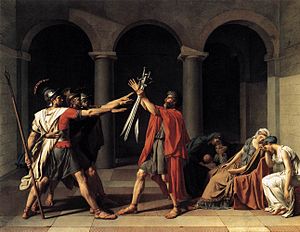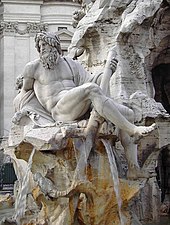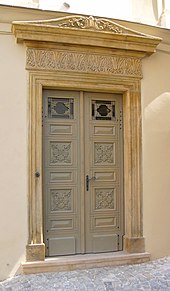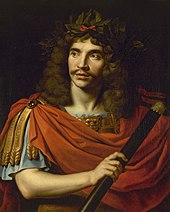Classicism Is an Art Style That Is Governed by One of the Following

Classicism, in the arts, refers more often than not to a high regard for a classical period, classical antiquity in the Western tradition, as setting standards for gustation which the classicists seek to emulate. In its purest grade, classicism is an aesthetic attitude dependent on principles based in the culture, art and literature of ancient Greece and Rome, with the accent on course, simplicity, proportion, clarity of structure, perfection, restrained emotion, besides as explicit appeal to the intellect.[1] The art of classicism typically seeks to be formal and restrained: of the Discobolus Sir Kenneth Clark observed, "if we object to his restraint and compression we are just objecting to the classicism of classic fine art. A violent emphasis or a sudden acceleration of rhythmic move would have destroyed those qualities of residue and completeness through which it retained until the present century its position of authorisation in the restricted repertoire of visual images."[2] Classicism, as Clark noted, implies a catechism of widely accepted ideal forms, whether in the Western canon that he was examining in The Nude (1956), or the literary Chinese classics or Chinese art, where the revival of archetype styles is too a recurring characteristic.
Classicism is a force which is often present in post-medieval European and European influenced traditions; however, some periods felt themselves more connected to the classical ideals than others, particularly the Historic period of Enlightenment,[3] when Neoclassicism was an important motility in the visual arts.
General term [edit]

Fountain of the 4 Rivers, Bernini, 1651.

Classicism is a specific genre of philosophy, expressing itself in literature, architecture, fine art, and music, which has Aboriginal Greek and Roman sources and an emphasis on society. Information technology was specially expressed in the Neoclassicism[4] of the Age of Enlightenment.
Classicism is a recurrent tendency in the Late Antique period, and had a major revival in Carolingian and Ottonian art. There was another, more durable revival in the Italian renaissance when the autumn of Byzantium and rising trade with the Islamic cultures brought a alluvion of knowledge about, and from, the antiquity of Europe. Until that time, the identification with antiquity had been seen equally a continuous history of Christendom from the conversion of Roman Emperor Constantine I. Renaissance classicism introduced a host of elements into European culture, including the awarding of mathematics and empiricism into fine art, humanism, literary and depictive realism, and formalism. Importantly information technology too introduced Polytheism, or "paganism", and the juxtaposition of ancient and modern.
The classicism of the Renaissance led to, and gave mode to, a different sense of what was "classical" in the 16th and 17th centuries. In this period, classicism took on more overtly structural overtones of orderliness, predictability, the use of geometry and grids, the importance of rigorous bailiwick and pedagogy, every bit well as the formation of schools of art and music. The courtroom of Louis XIV was seen as the center of this grade of classicism, with its references to the gods of Olympus equally a symbolic prop for absolutism, its adherence to axiomatic and deductive reasoning, and its love of order and predictability.
This flow sought the revival of classical art forms, including Greek drama and music. Opera, in its mod European class, had its roots in attempts to recreate the combination of singing and dancing with theatre thought to be the Greek norm. Examples of this appeal to classicism included Dante, Petrarch, and Shakespeare in poesy and theatre. Tudor drama, in particular, modeled itself later on classical ethics and divided works into Tragedy[5] and Comedy. Studying Aboriginal Greek became regarded as essential for a well-rounded education in the liberal arts.
The Renaissance also explicitly returned to architectural models and techniques associated with Greek and Roman antiquity, including the golden rectangle[six] as a key proportion for buildings, the classical orders of columns, as well equally a host of ornament and detail associated with Greek and Roman architecture. They as well began reviving plastic arts such every bit bronze casting for sculpture, and used the classical naturalism as the foundation of drawing, painting and sculpture.
The Historic period of Enlightenment identified itself with a vision of antiquity which, while continuous with the classicism of the previous century, was shaken past the physics of Sir Isaac Newton, the improvements in mechanism and measurement, and a sense of liberation which they saw as existence present in the Greek civilization, particularly in its struggles confronting the Persian Empire. The ornate, organic, and complexly integrated forms of the baroque were to give fashion to a serial of movements that regarded themselves expressly every bit "classical" or "neo-classical", or would rapidly be labelled as such. For example, the painting of Jacques-Louis David was seen equally an effort to return to formal residue, clarity, manliness, and vigor in art.[7]
The 19th century saw the classical historic period as being the precursor of academicism, including such movements as uniformitarianism in the sciences, and the creation of rigorous categories in artistic fields. Various movements of the Romantic period saw themselves as classical revolts confronting a prevailing trend of emotionalism and irregularity, for example the Pre-Raphaelites.[viii] By this point, classicism was old enough that previous classical movements received revivals; for example, the Renaissance was seen equally a ways to combine the organic medieval with the orderly classical. The 19th century continued or extended many classical programs in the sciences, about notably the Newtonian program to business relationship for the move of free energy between bodies by means of exchange of mechanical and thermal free energy.
The 20th century saw a number of changes in the arts and sciences. Classicism was used both past those who rejected, or saw every bit temporary, transfigurations in the political, scientific, and social world and by those who embraced the changes as a means to overthrow the perceived weight of the 19th century. Thus, both pre-20th century disciplines were labelled "classical" and mod movements in fine art which saw themselves every bit aligned with calorie-free, space, sparseness of texture, and formal coherence.
In the present twenty-four hours philosophy classicism is used every bit a term specially in relation to Apollonian over Dionysian impulses in guild and art; that is a preference for rationality, or at least rationally guided catharsis, over emotionalism.
In the theatre [edit]

Classicism in the theatre was developed by 17th century French playwrights from what they judged to exist the rules of Greek classical theatre, including the "Classical unities" of time, place and activeness, found in the Poetics of Aristotle.
- Unity of fourth dimension referred to the demand for the entire activity of the play to take place in a fictional 24-hour period
- Unity of identify meant that the activity should unfold in a single location
- Unity of activeness meant that the play should exist constructed around a single 'plot-line', such every bit a tragic dear affair or a disharmonize between honour and duty.
Examples of classicist playwrights are Pierre Corneille, Jean Racine and Molière. In the period of Romanticism, Shakespeare, who conformed to none of the classical rules, became the focus of French statement over them, in which the Romantics somewhen triumphed; Victor Hugo was amongst the first French playwrights to break these conventions.[nine]
The influence of these French rules on playwrights in other nations is debatable. In the English theatre, Restoration playwrights such as William Wycherly and William Congreve would take been familiar with them. William Shakespeare and his contemporaries did not follow this Classicist philosophy, in item since they were not French and besides because they wrote several decades prior to their establishment. Those of Shakespeare's plays that seem to display the unities, such as The Tempest,[10] probably betoken a familiarity with actual models from classical antiquity.
In architecture [edit]

Classicism in architecture developed during the Italian Renaissance, notably in the writings and designs of Leon Battista Alberti and the piece of work of Filippo Brunelleschi.[11] It places accent on symmetry, proportion, geometry and the regularity of parts equally they are demonstrated in the architecture of Classical antiquity and, in particular, the architecture of Ancient Rome, of which many examples remained.
Orderly arrangements of columns, pilasters and lintels, equally well as the utilize of semicircular arches, hemispherical domes, niches and aedicules replaced the more circuitous proportional systems and irregular profiles of medieval buildings. This way rapidly spread to other Italian cities and then to France, Deutschland, England, Russia and elsewhere.
In the 16th century, Sebastiano Serlio helped codify the classical orders and Andrea Palladio's legacy evolved into the long tradition of Palladian compages. Building off of these influences, the 17th-century architects Inigo Jones[12] and Christopher Wren firmly established classicism in England.
For the development of classicism from the mid-18th-century onwards, see Neoclassical architecture.
In the fine arts [edit]
- For Greek art of the 5th century B.C.E., see Classical art in ancient Hellenic republic and the Severe style
Italian Renaissance painting[thirteen] and sculpture are marked by their renewal of classical forms, motifs and subjects. In the 15th century Leon Battista Alberti was important in theorizing many of the ideas for painting that came to a fully realized product with Raphael's School of Athens during the High Renaissance. The themes continued largely unbroken into the 17th century, when artists such as Nicolas Poussin and Charles Le Brun represented of the more rigid classicism. Like Italian classicizing ideas in the 15th and 16th centuries, it spread through Europe in the mid to late 17th century.
Later classicism in painting and sculpture from the mid-18th and 19th centuries is generally referred to as Neoclassicism.
Political philosophy [edit]
Classicism in political philosophy dates back to the ancient Greeks. Western political philosophy is frequently attributed to the great Greek philosopher Plato. Although political theory of this fourth dimension starts with Plato, it chop-chop becomes complex when Plato's pupil, Aristotle, formulates his own ideas.[14] "The political theories of both philosophers are closely tied to their ethical theories, and their involvement is in questions concerning constitutions or forms of regime."[14]
Notwithstanding, Plato and Aristotle are non the seedbed merely simply the seeds that grew from a seedbed of political predecessors who had debated this topic for centuries before their time. For case, Herodotus sketched out a debate between Theseus, a male monarch of the time, and Creon's messenger. The contend merely shows proponents of republic, monarchy, and oligarchy and how they all feel about these forms of government. Herodotus' sketch is just i of the beginning seedbeds for which Plato and Aristotle grew their own political theories.[14]
Another Greek philosopher who was pivotal in the evolution of Classical political philosophy was Socrates. Although he was non a theory-builder, he oftentimes stimulated young man citizens with paradoxes that challenged them to reverberate on their own beliefs.[fourteen] Socrates idea "the values that ought to make up one's mind how individuals live their lives should also shape the political life of the community."[14] he believed the people of Athens involved wealth and coin too much into the politics of their city. He judged the citizens for the way they amassed wealth and power over simple things similar projects for their community.[14]
Just like Plato and Aristotle, Socrates did non come upwardly with these ideas alone. Socrates ideals stem back from Protagoras and other 'sophists'. These 'teachers of political arts' were the first to think and act as Socrates did. Where the 2 diverge is in the mode they practiced their ideals. Protagoras' ideals were loved by Athens. Whereas Socrates challenged and pushed the citizens and he was not as loved.[14]
In the finish, ancient Greece is to be credited with the foundation of Classical political philosophy.
Meet besides [edit]
- Classical tradition
- Quarrel of the Ancients and the Moderns
- Weimar Classicism
References [edit]
- ^ Caves, R. West. (2004). Encyclopedia of the City. Routledge. p. 112.
- ^ Clark, The Nude: A Written report in Ideal Form 1956:242
- ^ Walters, Kerry (September 2011). "Journal ARTICLE Review". Church History. 80 (3): 691–693. doi:10.1017/S0009640711000990. JSTOR 41240671. S2CID 163191669.
- ^ Johnson, James William (1969). "What Was Neo-Classicism?". Journal of British Studies. 9 (1): 49–seventy. doi:ten.1086/385580. JSTOR 175167.
- ^ Bakogianni, Anastasia (2012). "Theatre of the Condemned. Classical Tragedy on Greek Prison Islands by Thousand. VAN STEEN". The Journal of Hellenic Studies. 132: 294–296. doi:10.1017/S0075426912001140. JSTOR 41722362.
- ^ Palmer, Lauren (2015-10-02). "History of the Gold Ratio in Art". artnet News . Retrieved 2019-10-28 .
- ^ Galitz, Kathryn (October 2004). "The Legacy of Jacques Louis David (1748–1825)". www.metmuseum.org . Retrieved 2019-10-28 .
- ^ "Periodical ARTICLE The Pre-Raphaelites". Bulletin of the Fogg Art Museum. x (2): 62–63. November 1943. JSTOR 4301128.
- ^ NASH, SUZANNE (2006). "Casting Hugo into History". Nineteenth-Century French Studies. 35 (ane): 189–205. ISSN 0146-7891. JSTOR 23538386.
- ^ Pierce, Robert B. (Spring 1999). "Understanding "The Tempest"". New Literary History. 30 (two): 373–388. doi:10.1353/nlh.1999.0028. JSTOR 20057542. S2CID 144654529.
- ^ Department of European Paintings (October 2002). "Architecture in Renaissance Italian republic". www.metmuseum.org . Retrieved 2019-x-28 .
- ^ Anderson, Christy (1997). "Masculine and Unaffected: Inigo Jones and the Classical Ideal". Art Journal. 56 (2): 48–54. doi:10.2307/777678. ISSN 0004-3249. JSTOR 777678.
- ^ Larsen, Michael (March 1978). "Italian Renaissance Painting past John Hale". Periodical of the Royal Social club of Arts. 126 (5260): 243–244. JSTOR 41372753.
- ^ a b c d e f k Devereux, Daniel (2011-09-02). Klosko, George (ed.). "Classical Political Philosophy: Plato and Aristotle". Oxford Handbooks Online. doi:10.1093/oxfordhb/9780199238804.003.0007.
Further reading [edit]
- Kallendorf, Craig (2007). A Companion to the Classical Tradition. Blackwell Publishing. ISBN9781405122948 . Retrieved 2012-05-06 . Essays by diverse authors on topics related to historical periods, places, and themes. Limited preview online.
External links [edit]
- Renaissance & Classicism from encyclopedia
byfordcomprignate.blogspot.com
Source: https://en.wikipedia.org/wiki/Classicism
Belum ada Komentar untuk "Classicism Is an Art Style That Is Governed by One of the Following"
Posting Komentar